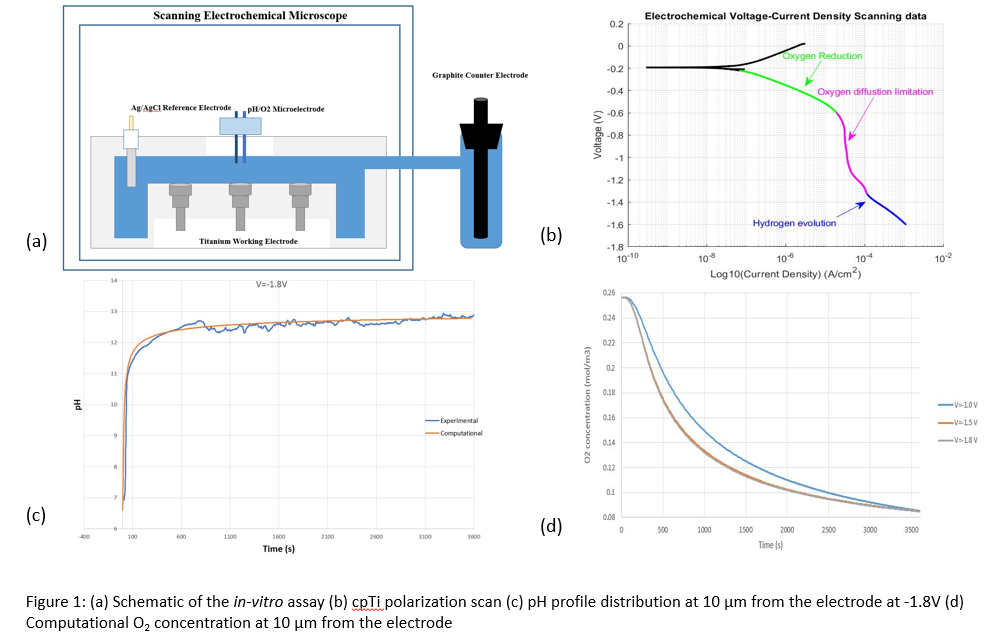Orthopedic implants used to replace or support a damaged bone or joint are susceptible to bacterial biofilm infections at the skin-contacting and bone-contacting sites, known as prosthetic joint infections (PJIs). These biofilms are hard to remove and are often resistant to conventional antibiotic treatments. This creates a need to design and develop new treatment procedures that can lead to complete eradication of biofilms on the surface of implants at a reduced financial cost and physical distress to patients. Electrochemical treatments are being developed for the treatment and prevention of orthopedic implant-associated infections. Cathodic Voltage-Controlled Electrical Stimulation (CVCES) is a minimally invasive technology for infection eradication without the need for implant removal. In CVCES, the metallic implant is utilized as a cathode and the biofilm is treated with a cathodic voltage. CVCES, in combination with antibiotics, has been shown to greatly reduce the bacterial burden on titanium implants in a rodent model of joint infection. Direct current flowing through the electrodes into the biofilm drives an electrolytic process that has a destructive effect on the bacterial biofilm. CVCES is a âvoltage-controlledâ process because the interfacial electrochemical properties of passivated metals utilized in orthopedics are voltage dependent. Because most bacteria have a negative surface charge, application of cathodic voltage leads to a negative charge-charge interaction resulting in electrochemical repulsion that promotes desorption of adherent bacteria from the electrode. This, along with the reduction reaction products, is why cathodic voltage is utilized to modulate the adjacent biological microenvironment.
Though CVCES is proven to be effective in biofilm eradication, many aspects and fundamental mechanisms with respect to the treatment protocol remain to be understood. In this work, we performed in vitro experiments and computational modelling to elucidate the key changes in the system leading to biofilm removal. An increase in pH and reduction in dissolved oxygen content near the cathode have been identified as two major factors that govern the electrochemical therapy. The mathematical models have been developed using the commercial multhiphysics software COMSOL (www.comsol.com), while experimental analysis has been done with a scanning electrochemical microscope using pH/O2 microelectrodes to map the spatial and temporal pH and O2 concentration profiles adjacent to cathodically-polarized commercially pure titanium (cpTi) working electrode. Cathodic voltage stimulations of -1.0V, -1.5V and -1.8V vs. Ag/AgCl reference electrode for a duration of one hour with a graphite counter electrode (anode). Saline electrolyte at an initial concentration of 0.154 M NaCl was used in the electrochemical chamber. In order for the computational models to predict electrochemical changes in the chamber, we first used experimental I-V data to extract the necessary kinetic parameters for the surface electrochemical reactions. Electrochemical potential scans were carried out on the working electrode and the resulting data was used to extract charge transfer coefficients and exchange current densities of the surface electrochemical reactions. We then designed two-dimensional computational models that solve Nernst-Plank equations with Butler-Volmer surface kinetics to predict time-dependent spatial distributions of species concentrations and electric potential. The pH and O2 concentrations were evaluated at a distance of 10 µm and 5 mm from the working electrode surface over the course of one hour. The pH at 10 µm from the electrode surface increased rapidly upon the application of cathodic voltage. Also, the magnitude of pH and its change rate increased with an increase in cathodic polarization at -1.0V, -1.5V an -1.8V. At a distance of 5 mm from the electrode surface, both the pH magnitude and change rate did increase but the effect was lower than at 10 µm, owing to the fact that diffusion plays a much greater role as compared to reaction rate at distances far away from the electrode surface. A significant decrease in dissolved O2 concentration was observed in the electrolyte at 10 µm from the electrode. However, as we increase the cathodic voltage magnitude from -1.0V to -1.8V there was no significant further reduction in O2 concentration. This is because at lower cathodic voltages the water reduction reaction becomes the dominant reaction and oxygen reduction reaction proceeds at the same rate. At a distance of 5 mm from the electrode surface, there was minimal reduction in dissolved O2 concentration. The computational results show satisfactory agreement with the experimental results at all these conditions. The mathematical models provide a complete picture of the spatio-temporal variation of the pH and O2 concentration at each of the three applied cathodic voltages. These models can be further developed to examine the effects of various operation parameters such as electrode size and spacing, magnitude of applied voltages and duration of treatment.

